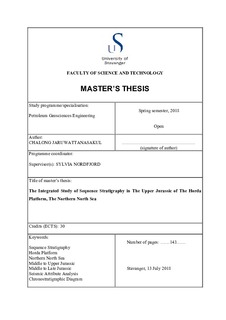| dc.contributor.advisor | Nordfjord, Sylvia | |
| dc.contributor.author | Jaruwattanasakul, Chalong | |
| dc.coverage.spatial | the North Sea | nb_NO |
| dc.date.accessioned | 2018-11-02T09:39:05Z | |
| dc.date.available | 2018-11-02T09:39:05Z | |
| dc.date.issued | 2018-07-13 | |
| dc.identifier.uri | http://hdl.handle.net/11250/2570734 | |
| dc.description | Master's thesis in Petroleum Geosciences Engineering | nb_NO |
| dc.description.abstract | The Northern North Sea area is one of the most prolific hydrocarbon provinces in the world. The great successful development of the Troll field leads to a search for hidden potential in the Horda Platform and surrounding areas. This resulted in the launching of this study with the aim of building an extensive study of sequence stratigraphy framework and depositional evolution in the upper Jurassic.
This study aimed to use the state-of-the-art 3D broadband cube, which acquired by CGG 2014-2016 combined with 18 key well data to build a new sequence stratigraphic framework for the upper Jurassic. The study result was linked to the petroleum significance to provide an opportunity and a new concept for further exploration and development work.
Seven key stratigraphic surfaces were interpreted in well data and mapped in 3D seismic data. Stratigraphic surfaces comprised the Top Brent, U60, FS50, U40, FS30, U20 and the BCU. The stratigraphic surfaces were divided into six stratigraphic units which were Unit 1 to Unit 6. The Units were classified into two tectonic periods during the upper Jurassic as Inter-rifting period; Unit 1 to Unit 3 and Syn-rifting period; Unit 3 to Unit 6
The stratigraphic interpretation indicated the overview sea level rise in the first order and interrupted with one sea level fall in the second order. The sea level played an essential role together with the tectonic event to control the depositional regime in the Horda platform, especially during the syn-tectonic rifting of the upper Jurassic. Four stratigraphic sequences were generated in the third order including three highstand system tracts, three lowstand system tracts, three transgressive system tracts and five sequence boundaries.
The seismic facies analysis were introduced to explain more high resolution detail of the depositional environment between key wells. The facies and paleogeographic maps suggested the marginal marine/delta environment to offshore marine in the Horda Platform. The high temporal and lateral variation of the study result referred to a completed system of petroleum elements. The depositional setting in the Horda Platform led to good source and seal deposits in Unit 6 which was correlated to the Draupne Formation. High potential reservoirs which were Unit 2, Unit 3 and Unit 4 can be correlated to the Krossfjord, the Fenfjord and the Sognefjord Formations which were the main potential for the Troll field. The tectonic and structural regime created excellent traps from rotated tilting fault blocks. Finally, the hydrocarbon was generated and charged from the Viking Graben during the post rifting period. | nb_NO |
| dc.language.iso | eng | nb_NO |
| dc.publisher | University of Stavanger, Norway | nb_NO |
| dc.relation.ispartofseries | Masteroppgave/UIS-TN-IER/2018; | |
| dc.subject | Horda Platform | nb_NO |
| dc.subject | Northern North Sea | nb_NO |
| dc.subject | petroleumsgeologi | nb_NO |
| dc.subject | sequence stratigraphy | nb_NO |
| dc.subject | seismic attribute analysis | nb_NO |
| dc.subject | chronostratigraphic diagram | nb_NO |
| dc.subject | middle to upper Jurassic | nb_NO |
| dc.title | The Integrated Study of Sequence Stratigraphy in The Upper Jurassic of The Horda Platform, The Northern North Sea | nb_NO |
| dc.type | Master thesis | nb_NO |
| dc.description.version | submittedVersion | nb_NO |
| dc.rights.holder | The master thesis of Chalong Jaruwattanasakul | nb_NO |
